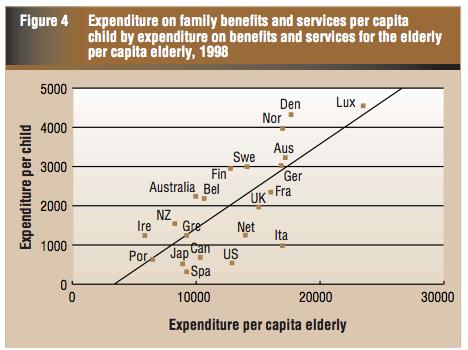Article
Fact-based, data-driven research and analysis to advance democratic debate on vital issues shaping people’s lives.
Center for Economic and Policy Research
1611 Connecticut Ave. NW
Suite 400
Washington, DC 20009
Tel: 202-293-5380
Fax: 202-588-1356
https://cepr.net
In a recent WaPo op-ed with the subtle title “Payments to Elders are Harming Our Future,” Harry Holzer and Isabel Sawhill claim that “our very expensive retirement programs already crowd out public spending on virtually all other priorities—including programs for the poor and those that strengthen the nation’s future—and will do so at even higher rates in the next decade and beyond unless we reform these large programs.”
If this crowd-out thesis were true, we would expect to find that nations that spend more on the elderly spend less on children. But this isn’t the case. Although a bit dated, the chart below, produced by researchers Jonathan Bradshaw and Emese Mayhew, plots expenditures on family benefits and services (per capita child) by expenditures on benefits and services for the elderly (per capita elderly).

The chart shows that counties that spend more per capita on the elderly also spend more per capita on children. Moreover, contrary to Holzer/Sawhill’s claim that we have “very expensive retirement programs”, U.S. expenditures on the elderly are moderate in cross-national terms. Bradshaw and Mayhew conclude: “we have found that if there is generational inequity it does not stem from demography alone. Nations make choices about the level of resources they commit to children and the elderly, and the countries that are most generous to children also tend to be most generous to the elderly.”
Similarly, in his important book Rich Democracies, Poor People: How Politics Explains Poverty, sociologist David Brady examines the relationship between child poverty and elderly poverty in 18 OECD nations and concludes:
One broad finding deserves to be emphasized here: there is no trade-off between elderly and child poverty. The evidence clearly shows that child and elderly poverty generally move in concert with each other and with a county’s overall poverty. Egalitarian counties with low overall poverty tend to have low child and low elderly poverty. These results flatly contradict [the crowd-out thesis]. Counties do no accomplish lower elderly poverty at the expense of higher child poverty, and child poverty does not worsen because of the pursuit of lower elderly poverty. The overriding pattern is a coherence among child, elderly, and overall poverty.
This should not be news to Sawhill and Holzer. In an interesting 2009 paper, Julia Isaacs, a researcher who works in the same shop as Sawhill at Brookings and who has also called for cutting Social Security and Medicare, acknowledges how little cross-national evidence there is for the crowd-out thesis. Here’s her summary of the evidence:
Several cross-national studies find that cash and near-cash benefits for children in the United States are quite low compared to most other rich nations. However, the picture changes radically when education and health expenditures are brought into the equation. The United States emerges as a country with higher than average child spending under a broad definition of public spending on children. Regarding spending on the elderly, the United States has a particularly strong age bias in pubic expenditures, although all OECD countries spend more, per capita, on cash benefits for the elderly than on cash benefits for families and children. Interestingly, cross-national research finds little evidence to support [the crowd-out] concern that spending on children will decline in face of increases in elderly populations and expenditures on the elderly. On the contrary, per capita expenditures on children and families increased during the latter part of the twentieth century in the United States and abroad. It is not clear whether this trend will continue or whether growing expenditures on the elderly will crowd out spending on children in the future. [italics are mine].
We certainly should do much more to provide economic security equal opportunity to children in the United States. But framing policy choices in “generational theft” terms and echoing plutocrats’ calls for cuts to benefits for working- and middle-class seniors will not produce the politics we need to achieve that goal. As Henry Aaron of Brookings puts it, in a commentary on Isaacs’ work that is worth reading in full:
Pitting the interests of the elderly and disabled against those of children is politically short-sighted because advocates of public outlays for children and for the elderly have been—and should remain—allies against those who believe that the role of government should be limited to providing for defense and public safety, and little else. Advocates of a restricted role for government remain a sizable and influential group in American politics. In a nation of two-party politics, progress is based on building and sustaining coalitions. If those who share the view that government should intervene actively to promote social welfare—for children, the disabled and poor, and the elderly—engage in fratricide, each of those groups will suffer.
The funny thing about kids is that their current and future living standards mostly depend on the living standards of their parents (and grandparents and other family members can matter a lot too). With this in mind, advocates with the best interests of children at heart need to focus on the real problem: policies that have redistributed the gains from economic growth upward over the last three decades, and away from middle- and working-class people, including parents and their children. If we really want working-class kids to get a better deal, we need to get serious about giving their parents a fairer one than they’ve been getting over the last three decades.